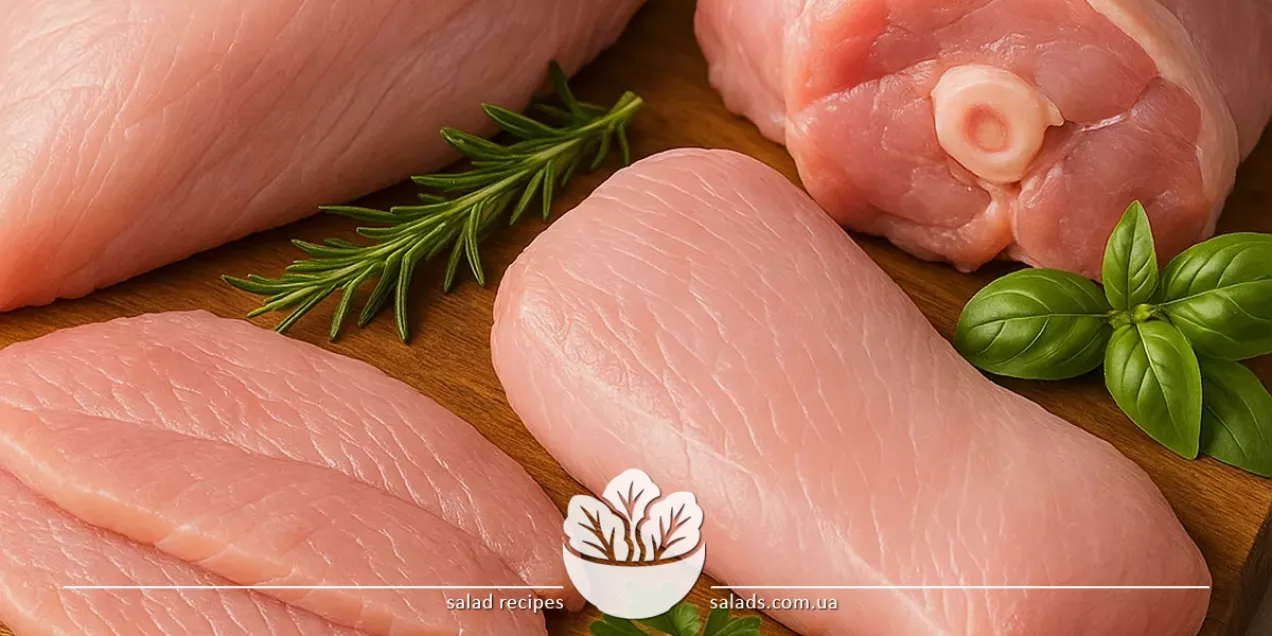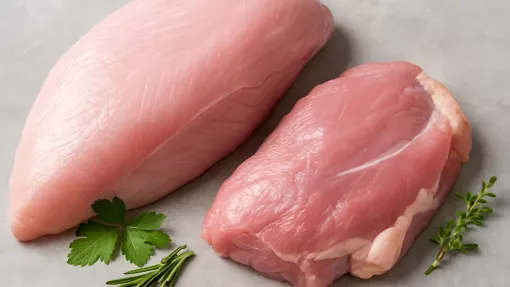Types of Turkey Meat

Types of turkey meat include various parts of the bird that differ in texture, flavor, and culinary application. With a high protein content, minimal fat, and pleasant taste, turkey is considered one of the best dietary products. It is suitable for both daily cooking and festive meals. In the poultry category, turkey is second only to chicken in popularity, but it surpasses it in nutritional density and amino acid content. Depending on the recipe, turkey can be baked, fried, stewed, stuffed, or boiled – its versatility opens up many culinary possibilities.
Different Types of Turkey Meat
Different Parts of the Turkey: Features and Uses
Turkey meat is divided into several main types depending on the carcass part, each with its own culinary properties and uses. The most valuable is the breast – it contains minimal fat and has a soft, uniform texture. Turkey fillet is often used in healthy dishes: pan-fried, steamed, baked, or sliced into steaks. It’s an ideal option for a dietary lunch, as it provides maximum protein with minimal calories. The thigh and drumstick are darker meat cuts with a richer flavor and denser texture. They are perfect for baking, stewing in sauce, or cooking in a slow cooker. Due to their higher fat content, they remain juicy even after prolonged cooking. These parts are often used for rolls, stuffed versions, or meat-and-vegetable casseroles.
Wings and necks are mainly used for broths and soups, providing rich aroma and deep flavor. They can also be stewed or cooked in an Asian style. A whole turkey carcass is a traditional choice for the holiday table. It is stuffed, baked in the oven, or cooked in foil with vegetables. Ground turkey forms a separate category – it is made from fillets or a mix of various cuts. It is excellent for making cutlets, meatballs, casseroles, and stuffed vegetables. For a richer taste, ground turkey often includes spices or vegetables, such as beans, enhancing the texture and increasing the nutritional value of the dish.
Nutritional Value of Turkey Meat
Turkey meat is known for its high nutritional value and health benefits. One hundred grams of turkey fillet contains up to 29 g of protein – more than chicken, beef, or many types of fish. Turkey meat is also low in fat – just 1-2 g in the fillet – making it an ideal product for weight loss diets. In addition to protein, turkey provides B vitamins (B3, B6, B12), which are crucial for metabolism, nervous system function, and blood production. Dark meat (thigh, drumstick) contains more zinc, iron, selenium, and phosphorus than white meat. These elements strengthen the immune system, improve skin condition, and support cardiovascular health.
Turkey meat contains virtually no carbohydrates, making it a frequent choice in ketogenic, high-protein, and low-carb diets. With its neutral taste, it pairs well with vegetables, grains, and sauces, allowing for complete and balanced meals. For example, turkey with mayonnaise is a classic casserole or festive salad option. Compared to red meat, turkey contains fewer purines, which reduces stress on the kidneys. As a result, it is suitable for people with hypertension, gout, or heart conditions. While dark turkey meat is slightly fattier, it is still significantly lower in calories than pork or lamb, maintaining all the benefits of a protein-rich product.
Culinary Techniques for Cooking Turkey
Turkey meat lends itself well to various cooking methods – from classic ovens and steamers to grills and slow cooking. The breast is perfect for quick thermal processing: pan-fried, baked in foil with vegetables, or prepared as stuffed rolls. To prevent drying out, the fillet is typically marinated or served with a sauce to retain its juiciness. Dark meat, such as the thigh and drumstick, is excellent for stewing. It stays juicy for a long time and becomes tender and soft after cooking. These parts are commonly used in casseroles, stews, soups, and stir-fry dishes. For special occasions, a whole baked turkey is especially popular – stuffed with rice, mushrooms, vegetables, apples, or dried apricots.
Ground turkey is a versatile ingredient for cutlets, meatballs, and vegetable fillings. With its mild flavor, it pairs well with spices, herbs, and sauces. For example, dishes based on ground turkey go perfectly with mushrooms, especially champignons, which add juiciness and a subtle earthy aroma. In addition to traditional methods, turkey can be smoked, dried, or made into pastrami. With seasoning, salt, and marinating, the meat becomes a savory snack or sandwich component. One popular method is baking the fillet with herbs and a bit of oil or cheese – this creates a golden crust while keeping the meat tender.
Storage and Handling of Turkey Meat
To preserve the flavor and nutritional value of turkey meat, it's important to follow proper storage and hygiene practices. Fresh meat should be refrigerated for no more than 2 days at a temperature of 0-4 °C. Ideally, it should be in vacuum packaging or a sealed container, separate from other foods – especially those ready to eat. Freezing extends the shelf life to 6-9 months. Before freezing, rinse and dry the meat, then divide it into portions for convenience. Defrosting should be done slowly, in the refrigerator over 10-12 hours – this helps preserve the muscle fiber structure and juiciness. Refreezing is not recommended.
Prepared turkey dishes can be stored in the refrigerator for 2-3 days. Afterwards, they should be reheated to 70 °C or frozen. It is also important to maintain hygiene when handling raw meat: use a separate cutting board and knife, wash hands thoroughly, and avoid mixing with other ingredients before cooking. Leftover turkey can be used in salads, appetizers, pâtés, or stuffed vegetables. For example, roasted turkey pieces pair well with corn and herbs in cold salads or on toast. This not only prevents waste but also provides a delicious snack or lunch option.
Turkey Meat in a Healthy Diet
Turkey meat rightly holds a key place in many healthy eating systems. Its high protein content and low fat levels make it ideal for those managing weight, digestive issues, or requiring a low-cholesterol diet. Turkey is easy to digest, gentle on the digestive system, and provides long-lasting satiety. In everyday diets, it can replace fattier meats while maintaining the nutritional value of meals without compromising health. The ideal combination is boiled or baked turkey with vegetables, whole grains, and light sauces. For athletes, turkey breast is often a primary source of post-workout protein – paired with carbohydrates and a small amount of fats.
Interesting culinary combinations with turkey can be made even from simple ingredients. For breakfast, a salad with turkey fillet, salt, olive oil, tomatoes, and boiled eggs works well. For lunch – braised turkey with potatoes or buckwheat; for a light dinner – a sandwich with a pâté made from ground turkey. Turkey also pairs well with other proteins. For example, boiled sausages made from turkey meat make a quick snack or appetizer ingredient. With its tenderness and neutral taste, turkey easily adapts to culinary traditions from various cultures and suits daily consumption in any form – from soups to casseroles.
